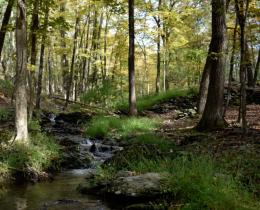According to researchers at Ohio State University’s Carbon Management and Sequestration Center, global agricultural methods have depleted soils of 50 to 70 percent of their carbon. Without carbon, soil loses its life—and it's much more difficult to grown nutrient-rich food in lifeless soil.
As the soil becomes less able to hold carbon, it also absorbs less of our carbon emissions. This leads to rising global temperatures, which can reduce crop yields, thus setting up a vicious circle of denuded soil, temperature rise, and hunger.
The best hope for reversing this trend can be found in agriculture itself. By employing a variety of regenerative farming techniques, we can improve the soil, produce quality food, and at the same time increase the amount of carbon stored in the soil. This is often referred to as "carbon farming."
What Is Carbon Farming?
The Carbon Farmers of Australia define carbon farming as "farming in a way that reduces greenhouse gas emissions, or captures and holds carbon in vegetation and soils. It is managing land, water, plants, and animals to meet the triple challenge of landscape restoration, climate change, and food security. It seeks to reduce emissions in its production processes, while increasing production and sequestering carbon in the landscape.”
There are numerous agricultural practices and techniques that fall under the category of carbon farming, including no-till cultivation, green manures, cover cropping, composting, biochar, permaculture, agroforestry, and grazing management. Anything that increases carbon storage in the soil, while also reducing carbon emissions, counts.
Each technique increases storage of carbon in different amounts. Eric Toensmeier, permaculture expert and author of The Carbon Farming Solution, explains the amount stored can range from “0.3 tons per hectare for conventional no-till with herbicide, to 2 or so for organic with cover crops and rotation, to 2-4 for good grazing, to 10 for many tree crops, and even 20 or more for ‘multistrata agroforestry systems’ like shade coffee or commercial-scale food forests.”
How Big of an Effect Can Carbon Farming Have?
350 parts per million (ppm) is the critical threshold of carbon dioxide in the atmosphere above which the effects of climate change, rising temperatures, melting ice, ocean acidification, and other related problems become more dangerous and potentially irreversible. In March 2015, for the first time since we started keeping records, the global average atmospheric concentration of CO2 topped 400 ppm for the entire month. The last time our planet witnessed similar CO2 levels was during the Pliocene Epoch, 2.6–5.3 million years ago.
According to Dr. James Hansen, former head of the Goddard Institute for Space Studies, “If humanity wishes to preserve a planet similar to that on which civilization developed and to which life on Earth is adapted, paleoclimate evidence and ongoing climate change suggest that CO2 will need to be reduced [from current levels] to at most 350 ppm.”
Carbon farming alone can't get us back to 350 ppm—we still need to reduce our use of fossil fuels, protect forests, improve efficiency, and invest in renewable energies—but, Toensmeier says, “It can sequester enough so that we can drop back to that magic number,” provided we cut out fossil fuels and deforestation this decade.
What Can You Do?
If you're not a farmer, Toensmeier recommends three things that can help with the effort to reduce carbon emissions and increase carbon storage in soil.
Grow your own food. This helps reduce carbon emissions related to food transportation. Even if you only have a windowsill or porch, every little bit helps.
Build up your soil. If you have a garden, implement practices to build the organic matter (which is 58% carbon by weight) in your soil, like mulching, composting, using organic practices, planting cover crops, etc.
Plant a tree. Perennial crops are even better than annuals at storing carbon. If you have a garden, plant some berries or fruit trees.



